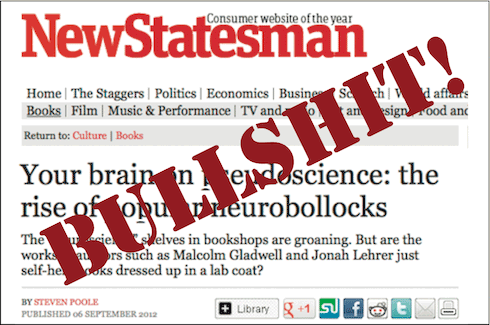To: Steven Poole
Subject: “Your brain on pseudoscience: the rise of popular neurobollocks.” (http://ow.ly/dST8L)
Mr. Poole,
As Queen Gertrude put it, ”The lady doth protest too much, methinks.”
It was interesting to read your clever attempt to hype your new book by kvetching about writers who use neuroscience to hype their books. It was even more interesting to notice how effectively you proved what you thought you were dismissing.
Granted, most of the books trying to jump on the neuro bandwagon aren’t as accurate and/or helpful as they promise to be. Still, the problem isn’t that there are too many misleading books on the subject, it’s that there isn’t enough research looking into recent discoveries that destroy most of your arguments.
The good news is that increasing numbers of researchers are at least starting to sniff in the right direction. It’s only a question of time until they connect all the dots that expose the full extent of dopamine-induced addictions.
The reason it’s taking so long to notice the obvious is because dopamine is so powerful that it’s keeping researchers from wanting to understand that every man-made problem can be traced to primitive ancestors who had more in common with apes than modern man. Our progenitors weren’t smart enough to comprehend what they were doing, but that didn’t stop them from cultivating the dopamine-induced survival behaviors that Homo sapiens share with chimpanzees (for food, sex, safety/power, acceptance/approval/attention, esteem/status) into addictions. If Abraham Maslow had called them addictive needs, instead of deficiency needs, everything would be different.
In addition to an array of acknowledged (drug, food, sex, gambling) and unacknowledged (safety, power, attention, esteem, money, religion) addictions, Homo sapiens inherited a powerful dopamine bias that reduces all decisions down to protecting and triggering dopamine flow.
Look at you. You seem like an intelligent fellow and yet you don’t realize that you’re wasting your time attacking writers for being more open-minded, insightful, popular, and successful than you are. If you understood anything about neurochemistry you’d also understand how dopamine-induced jealousy threatens your dopamine flow and sends you scrambling to crank out derisive articles and books to deal with the sense of withdrawal.
Convincing yourself that human behavior is too complex to explain in terms of neurotransmitters is simply another way to protect and boost esteem = protect and trigger dopamine flow.
There are logical reasons why it’s so easy to pretend that Homo sapiens’ behavior is more complex than chimpanzee behavior.
- Our species subjects far too many vulnerable offspring to far too much neglect, trauma, and abuse which produces huge numbers of damaged children, adolescents, and grownups who are plagued by fears, insecurities, inadequacies, and insatiable cravings for the safety, attention, and esteem that they didn’t receive in their formative years.
- Insatiable cravings send damaged children, adolescents, and grownups desperately seeking the dopamine triggered by foods, sex, safety/power, acceptance/approval/attention, esteem/status, gambling, money, religion, and drugs.
- The existence of so many seemingly disparate dopamine triggers mask the underlying problem and create the false impression that human behavior is inexplicably complex.
Reducing the many proximate addictions down to a single ultimate addiction to dopamine provides valuable insights into almost all human behaviors, starting with the desire to pretend that human behavior is too complex to explain in terms of brain chemicals.
For the healthy few, raised in nurturing and supportive environments, a little dopamine goes a long way because there aren’t any cravings or unfulfilled needs.
For the unhealthy many, the greater the neglect, trauma, and/or abuse, the more predisposed the neglected, traumatized, and abused are to acknowledged and unacknowledged addictions. Which explains why, for the unhealthy many, there can never be enough food, sex, safety/power, acceptance/approval/attention, esteem/status, dogma, drugs, and/or money — because there can never be enough dopamine to end the dopamine withdrawal that started in childhood and adolescence.
The biggest difference between acknowledged and unacknowledged addictions is that the less destructive addicts get vilified and the more destructive addicts get away with pretending that their addictions are normal, acceptable, and even admirable.
By playing “Mary Contrary” you’re employing a popular dopamine game to elevate your esteem, increase your sense of power, win the acceptance and approval of peers, and (hopefully) make lots of money (which can easily be converted into drugs, safety, approval, and status).
Why? To trigger a neurotransmitter in your brain that’s tricking you into wasting your time ridiculing research that explains how a brain chemical turned you into a self-deceptive dopamine puppet.
Since you’re under the spell of the same dopamine that junkies trigger with heroin, it’s no surprise that you exhibit the same symptoms of all addictions — self-deception, denial, and a dogged commitment to continue indulging your favorite dopamine triggers.
If this were the 17th century, you’d be writing books railing against heliocentrism.
Like it or not, there’s nothing you can do to stop the inevitable.
The time has come to wake up and smell the dopamine.





Discussion
Comments are closed.